This was published 2 years ago
The little Geelong theatre company smashing it on the international stage
Next weekend, Geelong’s Back to Back Theatre will pick up the International Ibsen Award, sometimes called the “the Nobel Prize for theatre”, in Norway. Why? For making audiences not only question their preconceptions about disability, but themselves. And sometimes, making them very uncomfortable.
By Susan Horsburgh
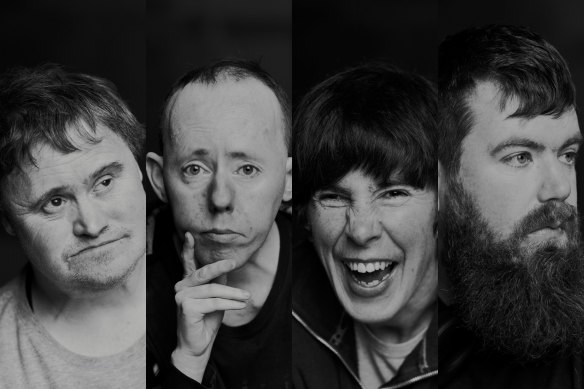
Members of the Back to Back’s core ensemble (l-r) Mark Deans, Simon Laherty, Sarah Mainwaring and Scott Price.Credit: Josh Robenstone
A dozen people are gathered in the black-box rehearsal space at Geelong’s Old Courthouse, the base for Back to Back Theatre, on this wintry Monday morning. Stage lights are beaming down, chairs are stacked against the walls. Actor Mark Deans, who has Down syndrome, wraps his arms around Back to Back’s artistic director, Bruce Gladwin, in a hug. He’s as short and round as Gladwin is long and lanky. With his silver beard and thick-rimmed black glasses, Gladwin gives off a reserved, professorial vibe, but he seems used to the workplace affection. “It’s quite familial,” he says of the 35-year-old company, which has a core ensemble of five full-time actors, all of them neurodiverse or with intellectual disabilities.
Seven actors start warming up for the workshop ahead – four from the ensemble and three guest artists, mostly recruited from Theatre of Speed, an experimental feeder company of young people who’ve encountered Back to Back through its residencies at local special schools. As Indian dance music plays, Deans rocks on all fours. Fellow actor Sarah Mainwaring swivels in slow motion while Simon Laherty, in a Bulldogs AFL jersey, lies on the floor doing hip bridges. Scott Price, the ensemble’s bolshie unofficial spokesman with the Ned Kelly beard, wanders in late and throws a few pretend punches before dropping to the floor and cycling his legs in the air. They all bend to touch their toes, with varying degrees of success.
Tamika Simpson, who has acted with the company for seven years and also has Down syndrome, watches from the corner, wearing a crocheted beanie with ornamental ears. Pandemic lockdowns have made her more anxious and insular, so she’s played more of an observer role in the rehearsal room of late. She sits in her customary three-chair set-up by the door and mumbles at full volume, monitoring the digital clock at her side to announce break times and sporadically taking Polaroid pictures of the performers.
An hour in, one of the guest actors quietly puts a jacket under her own head, and lies on her side on the floor while she has one of her regular seizures. The stage manager stays with her, and the workshop continues. No one seems fazed. “You have to be open to what’s happening in the space,” Back to Back artistic associate Tamara Searle says later, “and sometimes that is the material.”
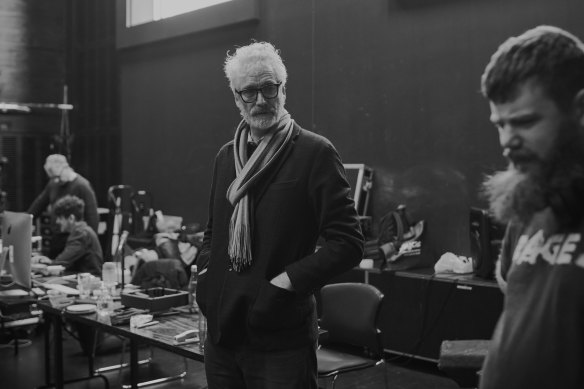
Artistic director Bruce Gladwin still remembers the first time he saw a Back to Back production: “What I saw was unlike anything I’d seen … it had a real punk aesthetic.”Credit: Josh Robenstone
There isn’t much that’s conventional about Back to Back, but maybe that’s why this unlikely troupe of performers from regional Australia has become one of the country’s most celebrated cultural exports. Pre-pandemic, it was spending up to half the year on tour, and even in 2022 it is set to rack up more than 18 weeks on the road. Back to Back may not be widely known outside arts circles, but it has been a favourite on the international festival circuit for the past two decades, wowing audiences with fresh, unforgettable productions that smash assumptions of what theatre can be. The New York Times has called one of its plays “a vital, sense-sharpening tonic for theatregoers who feel they’ve seen it all”, while the company’s debut feature film, Shadow, won an audience award at the South by Southwest festival in Texas in March.
“Many theatre companies love to think of themselves as edgy and dangerous, but no one gets closer to the edge than Back to Back,” says Australian performing arts veteran and former festival director Robyn Archer. “These authentic voices risk everything and emerge triumphant. They provoke us, they challenge us, they amuse us, they force us into deep thinking, and they bring us to our feet at the end.”
Earlier this year, Back to Back kicked its stellar reputation up a notch by taking out Norway’s International Ibsen Award, dubbed “the Nobel Prize for theatre”. The honour puts it in the company of such luminaries as the late English director Peter Brook and French theatre director Ariane Mnouchkine, and comes with a 2.5 million Norwegian krone ($370,000) cash prize.
Announcing the award, the Ibsen committee credited Back to Back with creating “some of the most memorable productions of 21st-century theatre” – “groundbreaking shows that ask questions of their audiences, of society, of each other”. Although delighted by the win, Gladwin wasn’t shocked. The global recognition, he says, is well-deserved and hard-won. “We spend a lot of time in our studio, tinkering away, making things,” says the 56-year-old, who will accept the award with the company in Oslo next weekend. “It feels incredibly reassuring that there are some people on the other side of the world who’ve noticed that.”
“Many theatre companies love to think of themselves as edgy and dangerous, but no one gets closer to the edge than Back to Back.”
In this Geelong rehearsal room, an hour’s drive south-west along the Princes Highway from Melbourne, Back to Back is devising a new work. In the ambitious, unsettling shows the group creates from scratch, it tackles topics as prickly as cultural appropriation and sexual politics, eugenics and artificial intelligence. Disability pops up too, but Back to Back usually has other issues in its crosshairs.
Today, the actors are brainstorming a new production with the working title Multiple Bad Things. As with every show, the actors have started with nothing more than a kernel – in this case, the idea of “displacement”. Over the usual period of three years – involving research, talking and improvisation (all recorded on video) – the group will conjure up a work that ponders some of the world’s most intractable woes, including racism and the climate crisis.
If it sounds like a creative high-wire act, it is. “Every day I’m freaking out,” says Searle, one of the two directors guiding the process. “It seems chaotic and messy and all over the place,” adds co-director Ingrid Voorendt, “but we’re trying to let a form emerge that will not answer the questions, but frame them. A lot of what’s been generated so far is quite funny and beautiful.” The performers, of course, are the ace in the company’s pocket: “They don’t need a playwright’s voice,” says Searle. “These actors have something to say.”
Still in the early stages of development, the show is the first to be directed by anyone other than Gladwin, and he is leaving Searle and Voorendt to it. The actors have so far talked to a US academic via Zoom about the “neuropolitics of race”, they’ve also spoken with three people displaced by the Lismore floods. Each day, the directors give the group tasks as entry points into the subject, to work out what the actors want to talk about.
Today, everyone has been asked to bring in a creation story. They range from Greek mythology to a Jewish folk tale to the Dreamtime story of the Rainbow Serpent. “Race is a bit of a theme with me at the moment,” explains Scott Price, an autism advocate who says he can relate to Indigenous oppression. Over the course of the day, the conversation covers topics such as the dawn of the cosmos, as pictured by NASA’s latest space telescope, but also personal failings. “Dogs and freak shows are my phobias,” says Price. “My weakness is, I can’t sit still.”
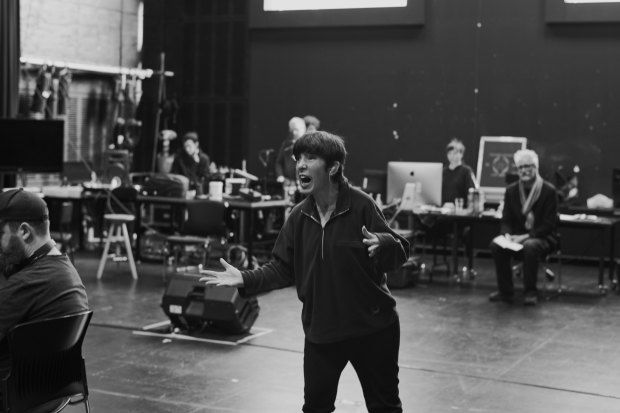
“The depth of what we talk about, the things we come up with, are much more powerful than what the average person would think,” says Sarah Mainwaring.Credit: Josh Robenstone
Sarah Mainwaring suspects their discussions would surprise outsiders. The 41-year-old actor, who has an acquired brain injury from a car accident when she was six, exudes a self-contained dignity, commanding attention with her slow, deliberate speech and the emotional weight behind every word.
Cerebral palsy causes her right hand to shake until she tucks it under her thigh. “The depth of what we talk about, the things we come up with, are much more powerful than what the average person would think,” she says. “People would underestimate what may or may not happen in that room, having seen [the performers]. But that could be me putting my own bias on it.” Back to Back, she says, prods at audience preconceptions because theatregoers can see people with disabilities “treated or recognised like individuals, not segregated”.
For Mainwaring, who lives with her father in Melbourne, making theatre and touring for the past 16 years has been transformative. “It’s really changed me,” she says. “It’s opened so many doors. It’s given me a new outlook and a whole way of seeing the world. It’s given me a life.”
Mark Deans, who joined the ensemble 33 years ago, doesn’t say a word all day in the workshop and dozes off for much of the afternoon, but he still loves acting with the company. In fact, his mum has walked past his room on the way to the toilet at 2am, only to find him sitting on the edge of his bed with his lunchbox beside him, fully dressed and ready for the taxi to take him to work. A natural clown, 54-year-old Deans is a strong physical performer with a well-timed side-eye, but Gladwin can see he’s slowing down. “Our biggest danger as a company is that we don’t become an institution in our own right,” he says, “because the actors do tend to stay for a long time.” The company, though, belongs to the ensemble, he says, and as long as Deans wants to keep acting, Gladwin will keep giving him roles that stretch his skills.
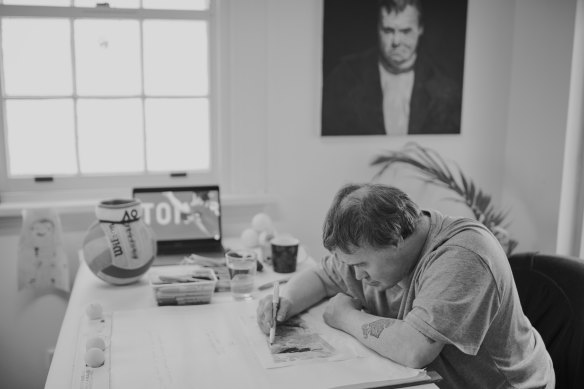
Mark Deans has been with the company for 33 years.Credit: Josh Robenstone
When Back to Back started in 1987, putting performers with disabilities on stage seemed a radical act – and perhaps it still does. Growing up in Melbourne’s outer eastern suburbs, the son of a policeman and a seamstress, Gladwin was inspired by the wild shows his older brother – actor, director and comedian Neill Gladwin – performed in at avant-garde inner-city venues such as The Last Laugh.
Still, he didn’t fall in love with theatre until he studied it for the teaching degree he didn’t end up using. He’d always been taught to look away from disabled people, which made the first Back to Back production he saw, in 1989, feel subversive. “It really blew me away, partly because my parents would say to me, ‘Don’t stare, don’t look.’ And here, I’d paid $20 to sit and [watch them]. I was confronted with a kind of taboo.” Gladwin was also intrigued by the anti-establishment ethos. “I’d studied theatre for four years and what I saw was unlike anything I’d seen – all these conventions were turned on their head and it felt like I was watching the birth of a new art movement,” he says. “It had a real punk aesthetic, like … ‘If you’ve got an interesting story, you should get up and tell it.’ ”
“It really blew me away, partly because my parents would say to me, ‘Don’t stare, don’t look.’ And here, I’d paid $20 to sit and [watch them].”
That show, Stinking Houses, was based on the true story of two people who’d lived all their lives at Melbourne’s Caloola Training Centre, a 19th-century mental hospital which housed some 500 people with intellectual disabilities until it closed in 1992. The pair became best friends, not knowing they were brother and sister. It wasn’t until deinstitutionalisation began in the 1980s that they were told. “The gravitas of that story I found really moving,” says Gladwin, who worked with the company as a guest actor a few years later, “and it was artists with disabilities telling that story.”
At the time, people with intellectual disabilities were moving into community-based housing and there was a need for more employment and recreational opportunities. Back to Back had emerged out of drama workshops held at disability service Corilong in Geelong. In the 2013 book We’re People Who Do Shows, Back to Back’s first artistic director, Cas Anderson, recalls working at Corilong in the mid-’80s and meeting Rita Halabarec, who would become one of the ensemble’s founding members: “[She] was sitting under a table just drawing – for months, years, I don’t know how long. She was scribbling into notebooks.”
Anderson offered to transcribe for her and “then we started writing these stories: ‘A bible. I go to church, Assembly Church, every Sunday. I listen to Pastor Hollands. He’s on the stage. He has an argument with God,’ ” says Anderson. “I started to get the inkling that these individuals … had creative things to say.” That creativity, combined with their physicality and powerful personal stories, made her want to direct an ongoing company that toured, rather than just occasional spectaculars. “There were a lot of one-off events back then,” she adds, “where people with Down syndrome were dancing. But [the organisers never] let them open their mouths.”
In the early days, audiences didn’t necessarily expect much. At one of the regional Victoria shows in 1991, the turnout was low, and afterwards they found out why: the organiser said he would have told more people to come “if he’d known it was going to be any good”.
Needless to say, the days of low expectations are long gone. Back to Back officially separated from Corilong in 1996 and “disability” isn’t even mentioned on the company’s “About us” on their website. The not-for-profit, which relies on a mix of government and institutional funding, as well as ticket sales and donations, is one of Australia’s few full-time professional acting ensembles, paying its performers above-award wages.
In the past, festivals would invite Back to Back to perform, assuming they wouldn’t have to pay the actors, but the company has always been adamant: “The budget line is the most important philosophical statement we’ve got,” says Gladwin. A regular pay cheque is rare for any actor, but it’s especially so for those with disabilities. When Gladwin first toured regionally with the company, he remembers everyone being given a $50 per diem. For many of the performers, the financial autonomy was a revelation. “It was the first time they’d been given cash,” he says, “because they’d lived in Caloola all their life, or their pension was controlled by their parents.”
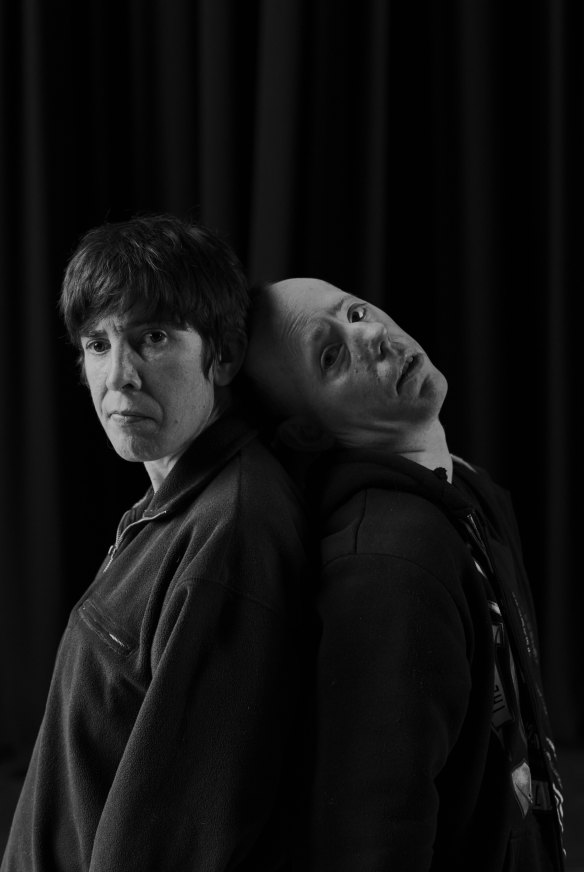
Sarah Mainwaring, left, and Simon Laherty, two of the company’s core actors.Credit: Josh Robenstone
In 1999, Gladwin took over as Back to Back’s artistic director with the goal of making great art – and if it happened to challenge prejudices, that was just a happy by-product. When the ensemble told him they wanted to tour the world, he set about making it happen, with provocative, boundary-pushing productions.
Not long after Gladwin took the helm, a reporter called for comment on the falling number of babies born with Down syndrome due to terminations following prenatal screening, which became the impetus for 2002’s Soft – a play which questioned the actors’ very existence. As part of their research, the ensemble spoke to scientists at Murdoch Children’s Research Institute about genetic testing. The video is in the company’s archives: “The scientist is talking to them about what Down syndrome is and they’re going, ‘Yeah, I’ve got that … I’ve got that,’” recalls Gladwin. “Ultimately, it was empowering.” In the production, an actor with Down syndrome played the doctor who tells a distraught couple that their unborn baby has the same genetic condition.
Back to Back has taken risks not only with its subjects but also staging – and sometimes the ensemble’s supposed limitations have led to its greatest successes. Take Small Metal Objects, which premiered at the 2005 Melbourne International Arts Festival and is still touring the world. Daunted by the thought of putting actors without vocal training in a big mainstream theatre, Gladwin set the show in Melbourne’s Flinders Street Station at peak hour, the actors wearing radio mics and performing inconspicuously among commuters, while the audience wore headphones and watched them from bleachers on the concourse. It was an unqualified hit, prompting about 50 international offers to perform and marking a turning point for the company.
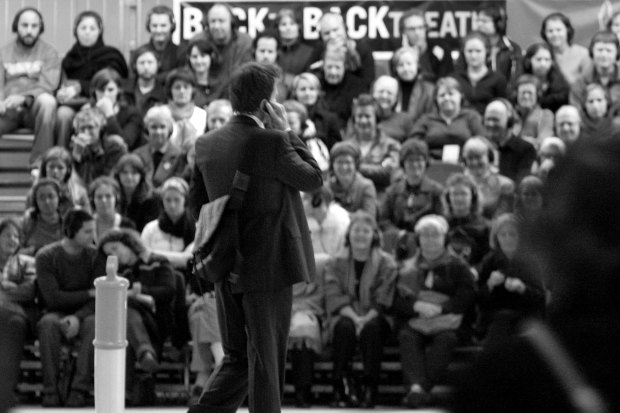
Small Metal Objects, which premiered in 2005, was set in Melbourne’s Flinders Street Station at peak hour. It is still touring the world.Credit: Craig Sillitoe
In the four-hander, Simon Laherty plays a drug dealer in emotional crisis whose business partner ends up ditching a deal in favour of their friendship. Laherty, who joined the ensemble in 2003, says Small Metal Objects is possibly his favourite Back to Back show, although it has had its downsides, especially on Melbourne Cup Day, when the actors had to contend with drunk racegoers. “They were flashing moonies and falling asleep in front of the seating bank,” he says. “I was in tears after the show.” It was even worse in Hamburg, where local drug dealers mistook him for a competitor: “They were saying, ‘This is our place – get off our turf.’ ”
It’s 3.30pm and, with work finished for the day, Laherty waits for a taxi to the Geelong home he shares with his father. He sits at the table in the Back to Back common room, production posters on the walls and Arnott’s Assorted Creams on the kitchen counter. The 41-year-old prides himself on his line-learning ability and prodigious knowledge of his idol, Britney Spears; he has an extensive collection of the singer’s merch and is working on a solo show about her. “It’s her figure,” he explains in his deadpan way. “The way she sings. The way she dances. The way she acts. The way she models.”
If he wasn’t working with Back to Back full-time, he says, he’d be doing “probably nothing – I’d just lay at home all day and get bored”. Instead, he travels the world and meets new people all the time: “We went to an opening-night party and this person invited me over to her table with her and her friends,” says Laherty, who, like the rest of the ensemble, is single. “They were asking, ‘How do you know your lines so well?’ ” Laherty identifies as someone with a disability, but prefers not to talk about it. “I like to show people that if you’ve got a disability, don’t be afraid to show what you can do – just go for it, roll with it,” he says. “Don’t think that as a person you can’t do anything.” Back to Back, he says, owes its success to the ensemble: “We use our own words and our own ideas. That’s why I think it’s so different.”
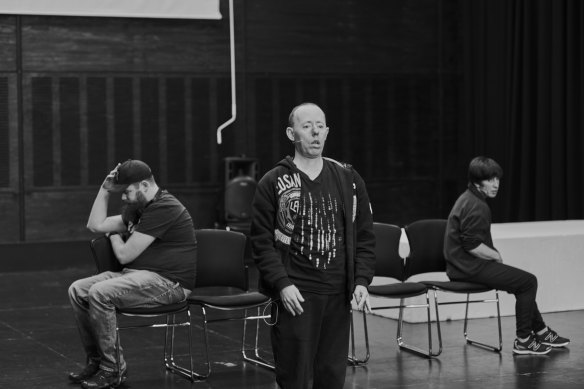
Simon Laherty (centre): “I like to show people that if you’ve got a disability, don’t be afraid to show what you can do – just go for it, roll with it.”Credit: Josh Robenstone
And discomfiting. Of all the works, Food Court probably has the highest walk-out rate, says Gladwin. In fact, when the play was performed at the Sydney Opera House in 2009 as part of Brian Eno’s Luminous festival, Eno himself left the theatre. He told Gladwin he couldn’t sit through it. Set in a suburban food court, it features two women who torment another, taking her to a forest, making her strip and brutalising her. It’s relentless and harrowing to watch. Adding to the unease is Sarah Mainwaring’s nudity, which raises uncomfortable questions about the actor’s agency, and sparks more second-guessing: are exploitation concerns reasonable or paternalistic? And what do they say about the theatregoer’s baggage around disability?
As it turns out, the choice to get naked was Mainwaring’s. In an improv, one of the bullies told her character to take her clothes off and she did, in 10 seconds flat. It put the Back to Back team in a difficult position, but they let it play out. “I wasn’t necessarily confident that it was going to lead to great material at the time,” says Gladwin. “But as it unfolded, it was quite incredible.” Mainwaring, who has a performing arts degree, says it was hard to strip off every night, but thrilling, too: “It was so elating to just be there in that moment with that character, with the audience. It was such a ride.”
Still, Gladwin welcomes those challenges. “People should ask those questions,” he says. “I mean, here’s a group of actors with disabilities, I’m a non-disabled director. There’s a lot of interest from audiences about how the work is made and what the power structures are.” When the ensemble was touring Food Court in Brussels in 2009, an audience member stood up at a post-show Q&A and said he didn’t believe the ensemble was capable of creating the work, essentially painting Gladwin as a puppet master.
Scott Price gave the man a serve and the insult ultimately spawned 2011’s Ganesh Versus the Third Reich, the company’s biggest critical triumph. “I feel slightly ashamed to admit that ego was a part of it,” says Gladwin, “but there was a real sense of, ‘All right, we’ll show them.’ ” Ganesh, about an elephant-headed Hindu deity who travels to Nazi Germany to reclaim the swastika, deals with questions of power and ethics in and out of the rehearsal room. It scored the Helpmann Award for Best Play in 2012 along with the Melbourne Festival Age Critics’ Award and a suite of Green Room gongs. Two years later, in 2014, it won a prestigious Critics’ Award at the Edinburgh International Festival.
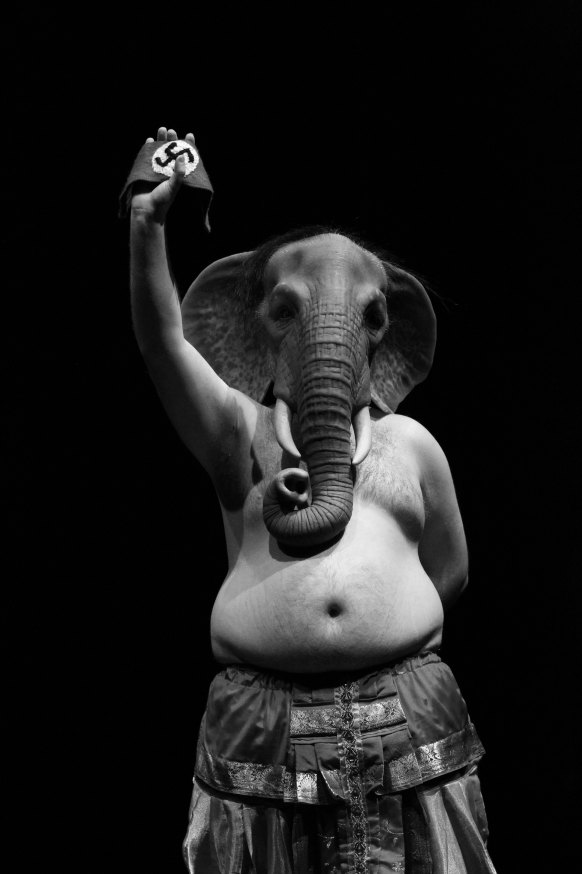
Ganesh Versus the Third Reich, the company’s biggest critical triumph, is about an elephant-headed Hindu deity who travels to Nazi Germany to reclaim the swastika. Credit: Jason South
It’s perhaps a measure of the company’s self-assurance that its most recent major work, 2019’s The Shadow Whose Prey the Hunter Becomes, is its most explicit exploration of disability yet. Set in a Geelong community hall, it features a group of activists with intellectual disabilities holding a meeting to discuss the threat of artificial intelligence. Among other things, they argue over the term “neurodiverse” and the meeting’s use of surtitles so the audience can understand what they’re saying. “It’s patronising,” says one of the activists. “I don’t want to be spat on and polished.” There are plenty of laughs, but the message is clear: once AI outstrips human intelligence, the “normal” people (as the actors call them) will be deemed as inferior as the intellectually disabled are now. “Get used to having a label around your neck,” she says. “Others will highlight your limits. You won’t always have rights over your own body.”
“I’ve seen them play to packed houses in Europe. People lose their shit for them.”
The award-winning 56-minute film adaptation, Shadow, screened as part of the Melbourne International Film Festival in August. As I joined the queue to get in, a woman behind me told her friends how Back to Back makes its work. “I’ve seen them play to packed houses in Europe,” she said. “People lose their shit for them.” After the movie, Scott Price entertained the crowd in a post-show Q&A, then the cast and crew gathered for drinks in a bar overlooking Federation Square. Off to Germany the next day, Price rejected the cider Gladwin offered him: “Take that back, man! Bruce, I’m about to get on a flight! A lemonade, please.”
After 15 years with the company, Price has been to five continents and 60-plus cities around the world, but the IT buff says acting wasn’t his first career choice. “This is not the job I wanted, but now I’ve become a public figure I can’t turn my back on these guys,” he says. “I need to help them find their voices in the community.” Price, who lives in “the Scotty flat” behind his parents’ house in Geelong, describes himself as a social media influencer on his blog site. The 35-year-old, who has “autism with anxieties” as well as verbal tics, wants to promote pride among those on the spectrum, he says, because they are targeted at school, work and in their own families every day. He recently gave evidence to the disability royal commission, detailing the “horrific” assaults and mistreatment he suffered at high school. “I didn’t even know how I could possibly live my life,” he says, avoiding eye contact. Price points out that three-quarters of those with autism are bullied at school: “I was one of those statistics and two of my cousins are, too.”
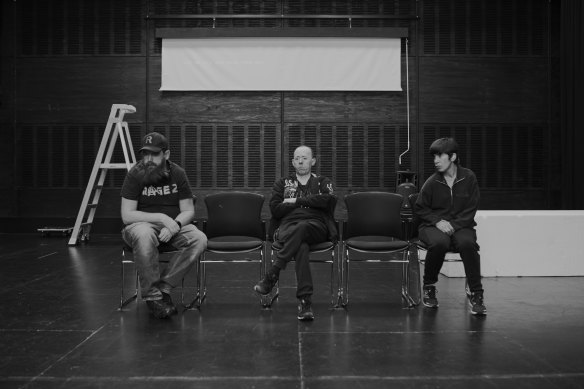
Scott Price, left, who has been with the company for 15 years, says that performances can be confronting for some audiences because “people are not used to seeing people with disabilities as they are. They think we’re all angels.”Credit: Josh Robenstone
Price reckons audiences find Back to Back shows “in your face” because of the swearing and the sex talk. “People are not used to seeing people with disabilities as they are,” he says. “They think we’re all angels.” A fan of the bands Rage Against the Machine and Warrnambool’s own Airbourne, Price is making a solo show called Sound Aid – about trying to save hard rock from teen pop (which must make for a tricky relationship with Britney-loving Laherty) – and he’s still on a high after the Ibsen Award win. “It’s the proudest achievement of my career,” he says. “After all the hardship I went through at school, this tops it.”
The award is certainly a sweetener after a tough two years. Back to Back had 19 Australian and international seasons cancelled because of pandemic-related restrictions and was forced to switch its focus to screen, education and community projects. The ensemble did a residency at Geelong special school Nelson Park, creating a quirky series of animations that screened on ABC ME. They also filmed Shadow in Geelong, offering people with disabilities internships as crew members supported by professional mentors.
The Ibsen prize money promises to give the company more creative freedom, says Gladwin, allowing them to start on a major work and “be a little bit more exploratory” without having to first secure funding.
Back to Back’s chair, former Australian Centre for the Moving Image director Katrina Sedgwick, says the company “has never been about a singular voice”, but agrees the visionary Gladwin has been critical to its success. “This is oxymoronic,” says Brett Sheehy, Melbourne Theatre Company’s artistic director from 2012 to 2021, “but Back to Back, to me, has been an eponymous company in everything but name – it’s been ‘Bruce Gladwin’s Back to Back’.” Gladwin, too, wonders whether he and the company can be separated. “It’s a question I keep asking myself,” he says. “It causes a little bit of grief for me, thinking about when is a good time to leave, or if I should.”
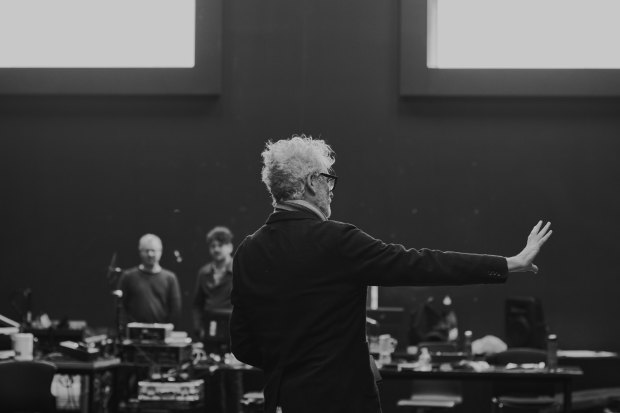
Brett Sheehy, Melbourne Theatre Company’s artistic director from 2012 to 2021, says, “Back to Back, to me, has been an eponymous company in everything but name – it’s been ‘Bruce Gladwin’s Back to Back’.” Gladwin is pictured here directing the ensemble in rehearsal.Credit: Josh Robenstone
The company’s fourth artistic director, Gladwin bats away any suggestion that he’s indispensable, but there’s no doubt his 23-year tenure has seen a phenomenal rise in its profile. Gladwin embraces chaos and embodies the company’s can-do spirit. When Mainwaring, for example, was having trouble remembering the script for 2016’s Lady Eats Apple, he had her lines embroidered onto Laherty’s costume so she could read them in their intimate scene together. And in May, when Laherty tested positive for COVID-19 hours before the opening night of The Shadow at Monash University, Gladwin tracked down a substitute in the company’s Theatre of Speed community program.
That actor, Chris Hansen, had never seen the show, but he performed that night, with Gladwin feeding him lines and stage directions through an earpiece. “I had no idea whether it was going to work or whether we’d have to cancel a show halfway through,” says Gladwin. Hansen pulled it off and flew to Brussels with the company four days later. “He’s gone from being unemployed, sitting in his house, to then going on a three-week tour of Europe.”
It’s that kind of chutzpah that has distinguished Back to Back from the start. At the company’s heart is a keen sense of our common humanity. The actors lay bare their pain and passions on the stage, gifting us a better understanding of our own.
“We throw the word ‘genius’ around way too loosely, but there is genius in what Bruce and that company have created.”
“We throw the word ‘genius’ around way too loosely, but there is genius in what Bruce and that company have created,” says Sheehy, who was an arts festival director for 17 years and has seen thousands of productions around the world.
“Back to Back has made us all sit up and think about our biases against neurodiverse or other-abled people … and blows all those preconceptions out of the water. Back to Back puts us all on notice that, yes, you can work with people with disabilities – so successfully, you can become one of the most exceptional theatre companies in the world.”
To read more from Good Weekend magazine, visit our page at The Sydney Morning Herald, The Age and Brisbane Times.